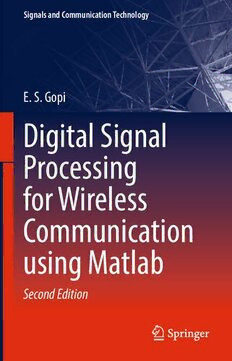Table Of ContentSignals and Communication Technology
E. S. Gopi
Digital Signal
Processing
for Wireless
Communication
using Matlab
Second Edition
Signals and Communication Technology
SeriesEditors
EmreCelebi,DepartmentofComputerScience,UniversityofCentralArkansas,
Conway,AR,USA
JingdongChen,NorthwesternPolytechnicalUniversity,Xi’an,China
E.S.Gopi,DepartmentofElectronicsandCommunicationEngineering,National
InstituteofTechnology,Tiruchirappalli,TamilNadu,India
AmyNeustein,LinguisticTechnologySystems,FortLee,NJ,USA
H.VincentPoor,DepartmentofElectricalEngineering,PrincetonUniversity,
Princeton,NJ,USA
This series is devoted to fundamentals and applications of modern methods of
signal processing and cutting-edge communication technologies. The main topics
are information and signal theory, acoustical signal processing, image processing
and multimedia systems, mobile and wireless communications, and computer and
communication networks. Volumes in the series address researchers in academia
and industrial R&D departments. The series is application-oriented. The level of
presentation of each individual volume, however, depends on the subject and can
rangefrompracticaltoscientific.
**Indexing:Allbooksin“SignalsandCommunicationTechnology”areindexedby
ScopusandzbMATH**
For general information about this book series, comments or suggestions, please
contact Mary James at [email protected] or Ramesh Nath Premnath at
[email protected].
Moreinformationaboutthisseriesathttp://www.springer.com/series/4748
E. S. Gopi
Digital Signal Processing
for Wireless Communication
using Matlab
Second Edition
E.S.Gopi
DepartmentofElectronics&
CommunicationsEngineering
NationalInstituteofTechnologyTrichy
TamilNadu,India
ISSN1860-4862 ISSN1860-4870 (electronic)
SignalsandCommunicationTechnology
ISBN978-3-030-82035-0 ISBN978-3-030-82036-7 (eBook)
https://doi.org/10.1007/978-3-030-82036-7
1stedition:©SpringerInternationalPublishingSwitzerland2016
©TheEditor(s)(ifapplicable)andTheAuthor(s),underexclusivelicensetoSpringerNatureSwitzerland
AG2021
Thisworkissubjecttocopyright.AllrightsaresolelyandexclusivelylicensedbythePublisher,whether
thewholeorpartofthematerialisconcerned,specificallytherightsoftranslation,reprinting,reuse
ofillustrations,recitation,broadcasting,reproductiononmicrofilmsorinanyotherphysicalway,and
transmissionorinformationstorageandretrieval,electronicadaptation,computersoftware,orbysimilar
ordissimilarmethodologynowknownorhereafterdeveloped.
Theuseofgeneraldescriptivenames,registerednames,trademarks,servicemarks,etc.inthispublication
doesnotimply,evenintheabsenceofaspecificstatement,thatsuchnamesareexemptfromtherelevant
protectivelawsandregulationsandthereforefreeforgeneraluse.
Thepublisher,theauthors,andtheeditorsaresafetoassumethattheadviceandinformationinthisbook
arebelievedtobetrueandaccurateatthedateofpublication.Neitherthepublishernortheauthorsor
theeditorsgiveawarranty,expressedorimplied,withrespecttothematerialcontainedhereinorforany
errorsoromissionsthatmayhavebeenmade.Thepublisherremainsneutralwithregardtojurisdictional
claimsinpublishedmapsandinstitutionalaffiliations.
ThisSpringerimprintispublishedbytheregisteredcompanySpringerNatureSwitzerlandAG
Theregisteredcompanyaddressis:Gewerbestrasse11,6330Cham,Switzerland
Idedicatethisbooktomybelovedmother
LateMrs.E.S.Meena
Preface
Thebookaimsindemonstratingdigitalsignalprocessingconceptsinvolvedinwire-
lesscommunicationusingMatlabwithrequiredtheoreticalexplanationforquicker
understanding. The book is divided into five chapters. The modulation techniques
like FSK, QPSK, and MSK and the methodology in computing the corresponding
spectral density are discussed in the first chapter. Hilbert transformation-based
bandpass to baseband conversion and spectral estimation using Barlett, Welch,
and Blackman-Tuckey techniques are also discussed in this chapter. In the second
chapter,multipathtimevaryingchannelmodel(continuousanddiscrete),coherence
time,coherencefrequency,DopplerspreadandtheDelayspreadarediscussed.The
probabilistic models like κ −μ, η−μ, Rayleigh, Rician, Nakagami distribution,
andcasestudyonFlatRayleighchannelmodelandRicianchannelmodelarealso
coveredinthischapter.
The third chapter covers the detection theory (Bayes technique, Mini-Max
technique,Neyman-Pearsontechnique),estimationtheory(MMSE,MMAE,MAP,
Wiener filter, Kalman filter, etc.), multiuser Massive MIMO, OFDM, and other
relatedtechniqueslikespatialdiversity,spatialdecoupling,raytracingmodel,beam
forming,OFDM,andCDMAarecoveredinChap.4.Recentpromisingtechniques
likenon-orthogonalmultipleaccess(NOMA),spatialmodulationtechniques,mul-
ticarriertransmissiontechniqueslikeOFDMANDOQAM,millimeterwavetrans-
mission model, cooperative communication model, full duplex transmission, and
unmannedaerialvehicle(UAV)-baseddatacollectionarediscussedinChap.5.
Thebookiswrittensuchthatitissuitableforthebeginnerswhoaredoingbasic
researchinwirelesscommunication.Itcanbeusedasthegraduatereferencebook.
Tiruchirappalli,TamilNadu,India E.S.Gopi
vii
Acknowledgments
I would like to thank Prof. Mini Shaji Thomas (Director, NIT, Tiruchirappalli),
Prof. S. Soundararajan, Prof. M. Chidambaram (IITM, Chennai), late Prof. K. M.
M. Prabhu (IITM, Chennai), Prof. P.Somaskandan, Prof. B. Venkataramani, and
Prof.S.Raghavanfortheirsupport.Iwouldalsoliketothanktheresearchscholars
Ms. K. Vinodha, Mr. P. Rajasekhar Poreddy, and Mrs. G. Jayabrindha for helping
in proofreading the manuscript. Special thanks go to my family members Mr. E.
Sankara Subbu, Mrs. G. Viji, Mr. A. G. Vasig, and Ms. A. G. Desna. I would
alsoliketothankthosewhohelpeddirectlyorindirectlyinbringingoutthisbook
successfully.
ix
Contents
1 ModulationTechniquesandSpectralDensityEstimation............... 1
1.1 AutocorrelationandtheSpectralDensityoftheReceived
BasebandSignalGeneratedbythePulsep(t) ....................... 1
1.2 ComputationofSpectralDensityoftheBandpassSignal........... 2
1.3 PulseShapingforDiscreteCommunication.......................... 4
1.4 BandpassModulationTechniques .................................... 7
1.4.1 PhaseShiftKeying .......................................... 7
1.4.2 IllustrationoftheCoherentCorrelationReceiver(PSK)... 8
1.4.3 FrequencyShiftKeying ..................................... 15
1.4.4 IllustrationoftheCoherentCorrelationReceiver(FSK)... 15
1.4.5 ComputationofProbabilityofError(FSK) ................ 20
1.4.6 ComputationoftheSpectralDensityofFSK............... 20
1.4.7 MinimumShiftKeying ..................................... 23
1.4.8 ComputationoftheProbabilityofErrorofthe
MSKModulation ............................................ 28
1.4.9 ComputationofSpectralDensityofMSKSignal.......... 28
1.4.10 QuadraturePhaseShiftKeying ............................. 31
1.4.11 ComputationoftheProbabilityofErrorofthe
QPSKSignal ................................................. 35
1.4.12 ComputationofSpectralDensityoftheQPSKSignal..... 36
1.5 CoherentVersusNon-coherentReceiver ............................ 38
1.5.1 ComputationoftheProbabilityofErrorforthe
Non-coherentDetection ..................................... 39
1.5.2 Non-coherentDetectionUsingMatchedFilter
andEnvelopeDetector ...................................... 41
1.6 RelationshipBetweenBasebandandBandpassW.S.S.
RandomProcesstheUsingHilbertTransformation ................. 46
1.7 SpectralEstimation.................................................... 49
1.7.1 DiscreteRealization.......................................... 50
1.7.2 TheBartlettMethod ......................................... 52
xi
xii Contents
1.7.3 TheWelchMethod........................................... 52
1.7.4 TheBlackmanandTukeyMethod .......................... 52
2 MathematicalModelofTimeVaryingWirelessChannelModel....... 55
2.1 Multi-PathModel ..................................................... 55
2.2 CoherenceTimeandDopplerSpread................................. 61
2.3 CoherenceFrequencyandDelaySpread............................. 66
2.4 DiscreteComplexBasebandTimeVaryingChannelModel
forWirelessCommunication.......................................... 69
2.5 ProbabilisticChannelModel.......................................... 71
2.5.1 κ–μDistribution............................................. 71
2.5.2 η–μ:Type1 .................................................. 72
2.5.3 η–μ:Type2 .................................................. 75
2.6 CaseStudy ............................................................. 77
2.6.1 CaseStudyUsingFlat-RayleighFadingModel ........... 77
2.6.2 ComputationoftheProbabilityofErrorofthe
Flat-RayleighFadingChannel............................... 80
2.6.3 CaseStudyUsingFlat-RicianFadingModel .............. 83
2.6.4 Computation of Probability of Error for
Flat-RicianFadingChannelModel ......................... 85
2.6.5 Baseband Single Tap Channel with Known
EstimatedFilterCoefficientg ............................... 88
3 Detection Theory and Estimation Theory for Wireless
Communication .............................................................. 93
3.1 DetectionTheoryforBinarySignalTransmission................... 93
3.1.1 TheBayesTechnique........................................ 94
3.1.2 TheMini-MaxTechnique ................................... 94
3.1.3 TheNeyman–PearsonTechnique ........................... 96
3.1.4 Illustration of the Bayes, Mini-Max, and
Neyman–PearsonDetectorforDiscreteChannel........... 100
3.1.5 Illustration of the Bayes, Mini-Max, and
Neyman–Pearson Detector for the Additive
GaussianNoiseChannel .................................... 117
3.2 EstimationTheory..................................................... 125
3.2.1 MinimumMeanSquareEstimation(MMSE)............. 125
3.2.2 MinimumMeanAbsoluteEstimation(MMAE) .......... 126
3.2.3 MaximumAPosterioriProbability(MAP) ............... 126
3.2.4 Log-LikelihoodEstimation.................................. 127
3.2.5 TheWienerFilter ............................................ 128
3.2.6 TheKalmanFilter ........................................... 136
4 Multiple Input Multiple Output (MIMO), Orthogonal
FrequencyDivisionMultiplexing .......................................... 141
4.1 MIMO.................................................................. 141
4.1.1 Zero-ForcingEstimator...................................... 142
4.1.2 Linear Minimum Mean Square Estimation
(LMMSE) .................................................... 144

